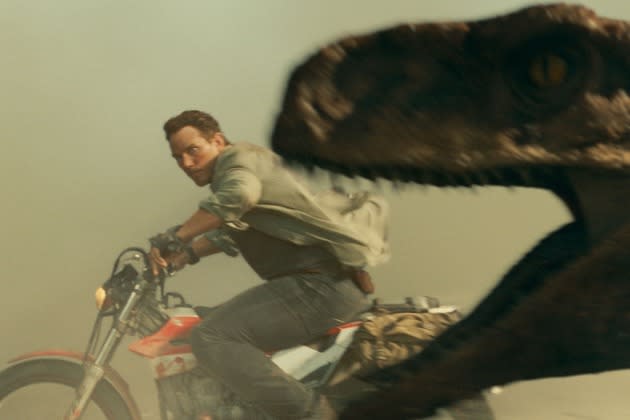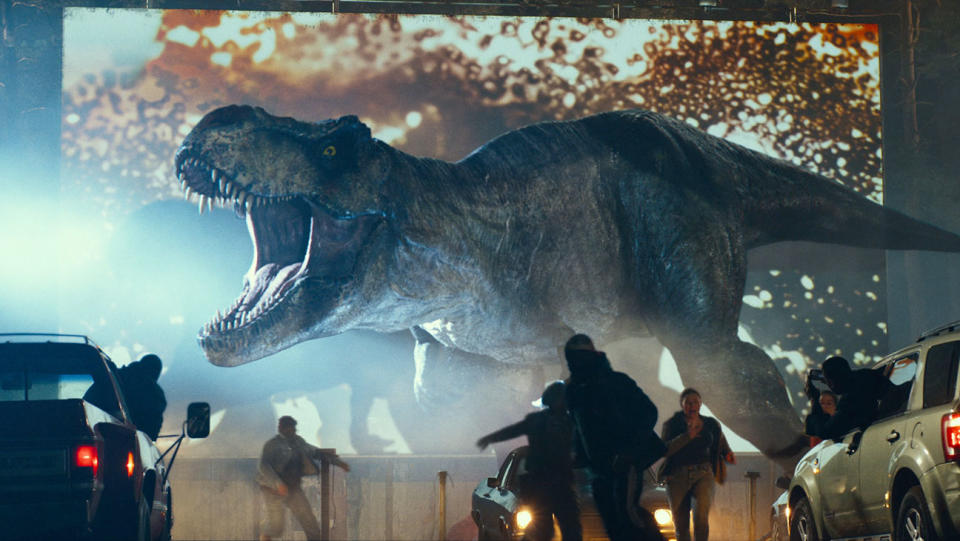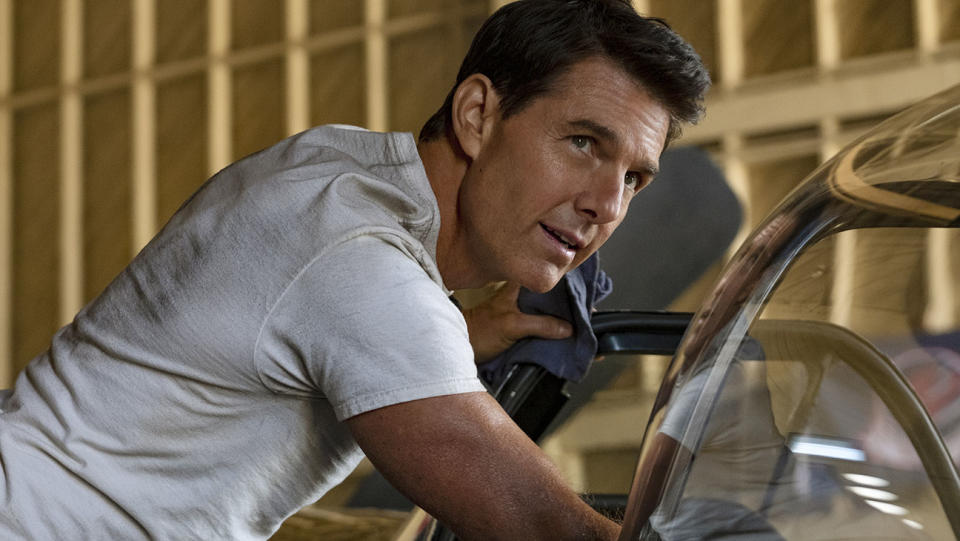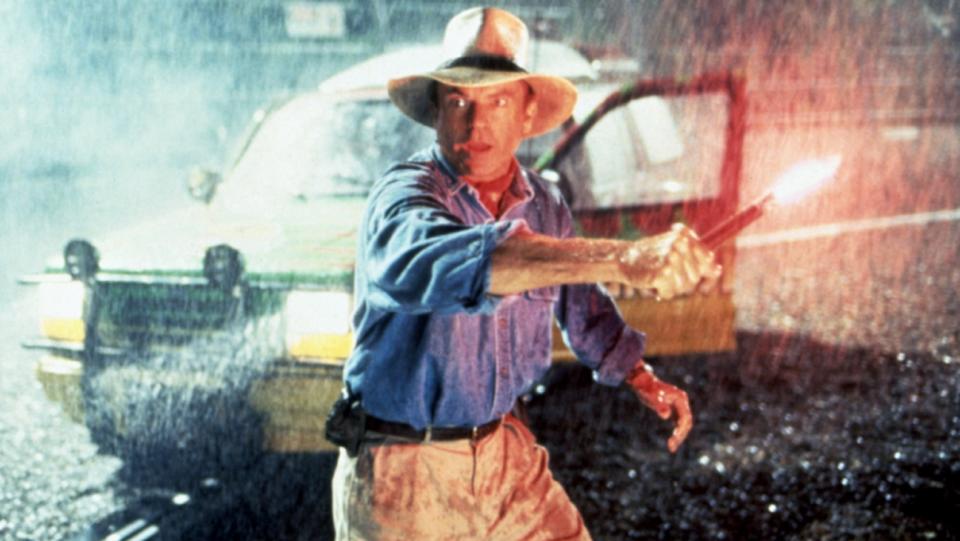‘Jurassic World Dominion’ Tests Sustainability of a Franchise
- Oops!Something went wrong.Please try again later.
- Oops!Something went wrong.Please try again later.
- Oops!Something went wrong.Please try again later.

“Bigger. Why do they always have to go bigger?” Dr. Ian Malcolm’s (Jeff Golblum) question about Jurassic World Dominion’s new carnivorous antagonist, the Giganotosarus, could be applied to the Jurassic film series as a whole. It could even be attributed to the vast majority of franchise filmmaking today, which is a game of constantly attempting to top the previous entry amidst ever-shifting audience expectations, a game of balancing nostalgia with the new.
How long can this game last? Eventually the sustainability of a franchise, especially those originally founded on relatively simple premises, has to reach a breaking point.
More from The Hollywood Reporter
Box Office: 'Jurassic World Dominion' Roars Ahead of 'Lightyear' in Surprise Upset
'Jurassic World: Dominion' Director Colin Trevorrow Has Perfect Response to T-Rex Criticism
'Jurassic World Dominion' Director Reveals Most Challenging Dinosaur to Create
Jurassic World Dominion, which sees Colin Trevorrow return to the director’s chair following J.A. Bayona’s Jurassic World: Fallen Kingdom, is certainly bigger. From its runtime, cast of characters from two generations, and number of subplots, Dominion is the biggest Jurassic film ever. (It’s also earning big at the box office this weekend.) Of course, bigger doesn’t always mean better, as the reviews, the lowest of the franchise, have suggested. If you’re expecting another critical pan here, well, you’re reading the wrong writer. I’m not particularly interested in “better than” or “worse than” conversations at the moment. But for now, I will say I enjoyed Dominion, in part because it’s such a clear testament to the strengths and weaknesses of the blockbuster film business.
Courtesy of Universal Pictures and Amblin Entertainment
Why go bigger? Because we clamor for it, and we have done so ever since Darth Vader revealed Luke Skywalker’s parentage in 1980. That move drove sequels — from The Temple of Doom (1984) to The Dark Knight (2008) — to attempt to reach the heights of Empire Strikes Back. Some succeeded, and others failed miserably. Despite that, we send a message with our fandom, our social media chatter, and most importantly our wallets, that we want bigger — longer runtimes, more characters, more set pieces and higher stakes.
At the same time, audiences crave familiarity, to be reminded of how they felt watching that first entry. This requires a balancing act. Overly familiar sequels have a hard time justifying their existence, yet a sequel that seemingly strays too far from the original is oft-regarded as something that shouldn’t be canon. We’ve seen the argument of the “overly” familiar with Jurassic World (2015) and The Force Awakens (2015), and the ”excessively” off-brand with The Last Jedi (2017) and Jurassic World: Fallen Kingdom (2018). And we’ve seen attempts to swing the needle back the other way and balance the new and the old, with The Rise of Skywalker (2019) and Jurassic World Dominion, films that left many fans frustrated.
Expectations become harder to manage the longer a franchise runs. We’ve seen it happen time and time again with Terminator, Fast and Furious, The Wizarding World and Transformers. Even the unshakable MCU has faced its share of post-Endgame (2019) growing pains, as Marvel challenges audience expectations with projects such as Eternals.
Undoubtedly, one of the chief reasons Top Gun: Maverick has proven to be such a stellar success story since launching over Memorial Day weekend is that it isn’t Top Gun 5. We haven’t been inundated with sequels, spinoffs, animated series, and network reboots in the years since Top Gun (1986). Yes, there’s stellar filmmaking by Joseph Kosinski at play, and the undeniable power of our last movie star, Tom Cruise, who’s also managed to keep rejuvenating the Mission: Impossible series. But Maverick doesn’t have to defy expectations or break the wheel of a Top Gun movie. Instead, it gets to revel in its own nostalgia while still feeling fresh, thus enabling it to surpass the original without deconstructing the franchise.
Courtesy of Paramount Pictures
When it comes to Jurassic Park sequels, only the first Jurassic World has received mostly positive reviews, and even those were somewhat reluctant, aided by the fact that it had been 14 years since Jurassic Park III (2001) and that newly minted leading man Chris Pratt was its star. Of all the sequels, Jurassic World had the most common with Spielberg’s original, yet outside a fresh coat of paint and a subplot involving military interest in trained raptors, it did the least to move the franchise forward. It was a film that aimed to wow an audience by going bigger and reminding viewers why they fell in love with Jurassic Park (1993) in the first place.
But it was also a film that also served as a warning: you can’t go back. The thrill of seeing dinosaurs like we did in 1993 can’t be replicated, and whether it’s called Jurassic Park or Jurassic World, the idea of dinos set loose in a theme park cannot support a franchise on its own. Instead, Trevorrow charted forward with the rather fascinating theory that if humans can clone dinosaurs, they can also clone other living things, introduce new species, new weapons, new medicines and food sources, and eventually change the ecology of the world.
Everett Collection
Even Spielberg understood that he couldn’t surpass what he did in the first, so he shifted directions and delivered a pulp adventure story with the bones of King Kong (1933) and The Lost World (1960) in The Lost World: Jurassic Park, which was only loosely based on Michael Crichton’s sequel novel. And Joe Johnston’s Jurassic Park III became a brisk survival story that trades likable characters for fast-paced action. The through-line of all the Jurassic sequels is that they are B-monster movies with multiple genre elements and a bit of finger-wagging about the dangers of tampering with nature, which are the kind of stories Crichton excelled at. There’s a reason why every adaptation of his work outside the first Jurassic Park and HBO’s Westworld, are firmly B-movies. It’s baked into the source.
Trevorrow, who took over the franchise and co-wrote each of the Jurassic World entries, has been dogged by the idea that he was merely chasing the 1993 film. Yet, I don’t believe he was. I believe Trevorrow, quite consciously and not without a sense of humor, remained very much aware that for the franchise to continue, it had to test the boundaries of how far he could push the concept of dinosaurs existing alongside humans in the modern world. As a result, Fallen Kingdom played to Bayona’s strengths and began as a disaster movie before shifting the action off the island and becoming a gothic horror story that blended Resident Evil with Dino Crisis, and introduced a cloned girl, Maisie (Isabella Sermon), being hunted by a genetically engineered monster in an old mansion. The conclusion of that film, which saw dinosaurs let loose in the world, promised humans living with dinosaurs.
But as Dominion shows in its opening, dinosaurs living among humans, eating them and wrecking cars is a neat montage, but it’s not a narrative that we haven’t seen in countless kaiju films. Instead, Dominion, seemingly to many people’s dismay, becomes about genetic research company BioSyn’s attempt to control both the food and health industries, with dinosaurs a means to that end. BioSyn owner Lewis Dodgeson (Campbell Scott) and scientist Dr. Henry Wu (BD Wong) connect the film back to the first, but their interests go beyond dinosaurs and theme parks, and instead rest on the future of life on this planet. The fact that this movie was shot during COVID-19 adds an extra layer to its environmental leanings, and what we’re willing to sacrifice in order to believe that we control nature.
Dominion also features the most locust action since The Exorcist II: The Heretic (1977), a sequel that also tried to go bigger but was panned upon release. Notably, Martin Scorsese prefers it to Friedkin’s original, which is motive enough to at least reconsider any critically maligned sequel to a classic, if that entices anyone. In all seriousness, Jurassic World Dominion is a franchise entry that feels less like Spielberg and the most like Crichton’s bibliography, a grab-bag of elements from The Andromeda Strain, Westworld, Congo, Prey and Jurassic Park.
Dominion defies what some people hoped to see. It is perfectly understandable that there was an expectation to see new and old characters team up to deal with dinosaurs attacking people around the world. But Ian Malcolm, Alan Grant (Sam Neill), Ellie Sattler (Laura Dern), Owen Grady (Chris Pratt), Claire Dearing (Bryce Dallas Howard), Maisie Lockwood, Kayla Watts (DeWanda Wise) and Ramsay Cole (Mamoudou Athie) don’t come together until the final act. The result is a third act that is weirder, messier and more interesting. Despite a handful of callbacks, it’s not Jurassic Park. That seems to be the point. The franchise has evolved and become something else in order to sustain itself. Is that then a signal to end it? Should Hollywood let it lie for now and be dug up again by some future generation?
I’m sure a number of you are nodding yes. I understand. Yet, I’ll counter. I think the only reason to continue a franchise that has gone this many years is to let it become something else. This is a franchise in which, at one time, was going to include Jurassic Park IV featuring rockets strapped to raptors sent into war zones. It’s a franchise that once proposed having a group of mercenaries who were dino-human hybrids. These ideas are extreme leaps from where the 1993 film began, and yet, the Jurassic World trilogy has laid the groundwork in which both of these scenarios are still ridiculous, yet plausible in the world that’s been established. I say bring it on.
Jurassic Park is undeniably a masterpiece, but if there’s any future in this franchise, we have to accept that no subsequent films can attempt to match it. For some, this means calling the franchise’s time of death. But as Spielberg, Johnston, Bayona and Trevorrow all showed with their sequels, it can also simply mean letting go, running wild and going bigger. Maybe there’s a masterpiece on the other side of that, or maybe there’s just more B-monster movies like the kind that inspired Crichton and Spielberg in the first place. That’s a legacy better than most franchises can hope for.
Best of The Hollywood Reporter




